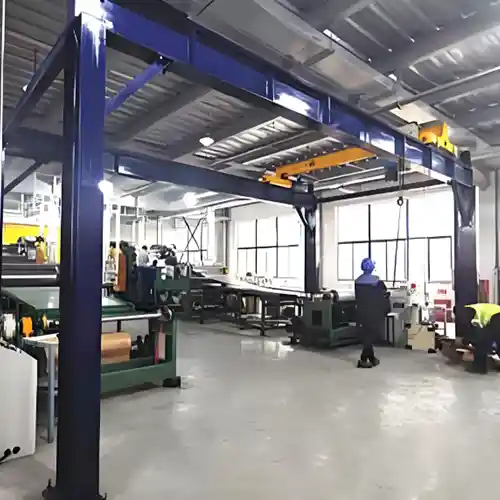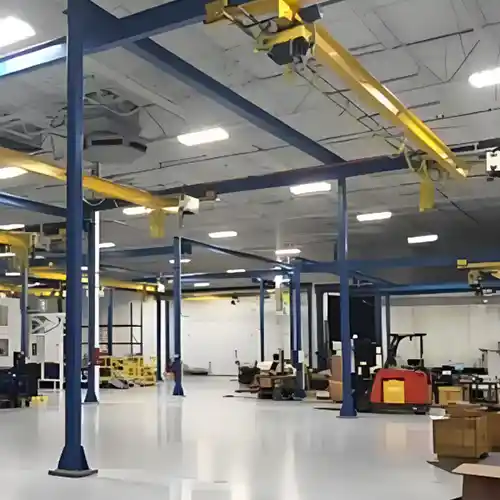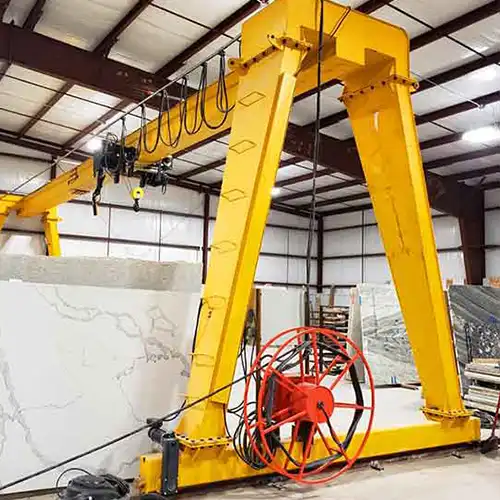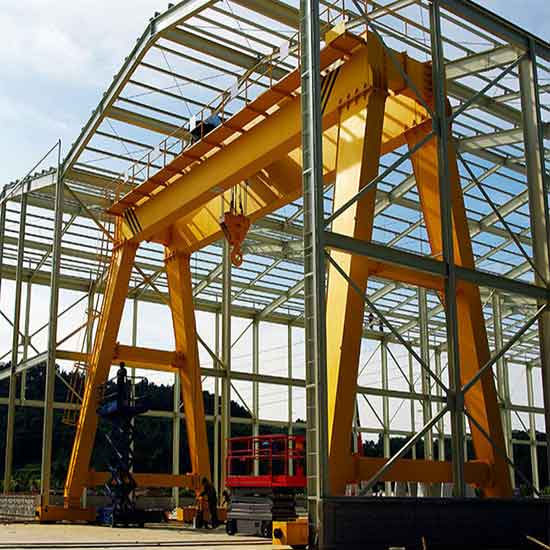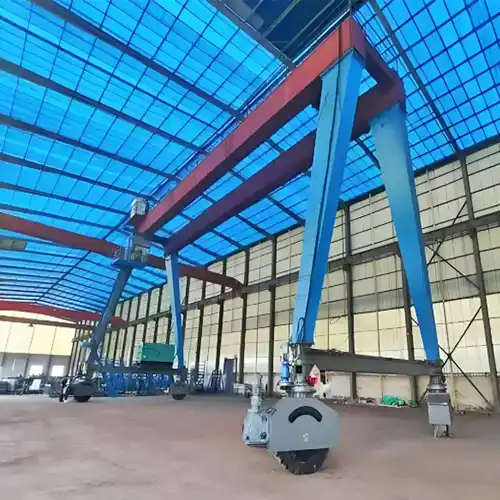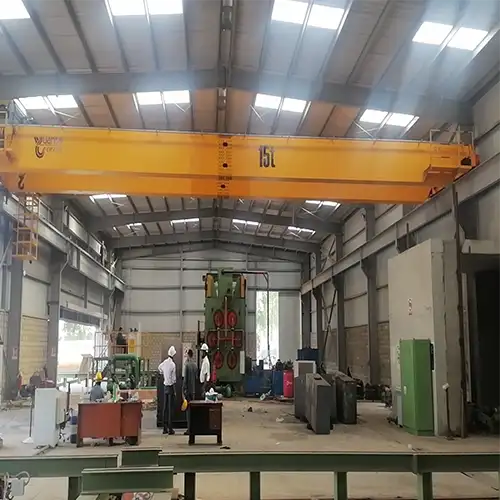Freestanding Bridge vs Gantry Cranes for Indoor Workshops
Compare freestanding bridge and gantry cranes for indoor workshops. Learn which crane suits your floor space, lifting needs, and workflow best.
Category: Featured
Your Trusted Freestanding Overhead Crane Manufacturer & Supplier
Freestanding Crane for Sale
Freestanding Bridge Crane vs. Freestanding Gantry Crane for Indoor Workshops
Working in a workshop or indoor facility without strong roof beams or built-in crane runways can make lifting heavy loads a real challenge. Many facilities—especially older warehouses, rented spaces, or smaller plants—simply weren’t built to handle traditional overhead cranes.
Why Freestanding Cranes Matter
Freestanding cranes are designed to carry heavy loads without relying on the building structure. They stand on their own, either on columns or floor-supported legs, making them perfect for:
- Workshops with low ceilings or irregular layouts
- Rented or temporary facilities
- Spaces where adding structural reinforcements is costly or impractical
By using freestanding cranes, you can safely move steel plates, machinery, molds, or other heavy materials while keeping floor space as open as possible. They also let you plan your workflow around the crane rather than forcing the crane to fit the building.
Purpose of This Guide
If you’re a crane buyer, this guide is here to help you:
- Understand the difference between freestanding bridge cranes and gantry cranes for indoor use
- Evaluate which crane type fits your facility, lifting needs, and budget
- Learn practical tips on headroom, floor space, capacity, and installation
- Avoid common mistakes when choosing a crane for workshops without supporting runways
By the end, you’ll have a clear idea of which solution works best in real-world conditions—saving you time, money, and headaches.
What Are Freestanding Cranes?
For workshops or indoor facilities without built-in runway structures, freestanding cranes provide a safe and reliable way to lift and move heavy loads. They don’t depend on the building for support and can be customized to fit different floor layouts and headroom constraints. The two main types are freestanding bridge cranes and freestanding gantry cranes.
A freestanding bridge crane features a horizontal bridge girder that spans between independent columns. This type of crane is designed to give maximum coverage over the workspace while keeping the floor relatively clear. It's particularly well-suited for facilities that require high hook heights and heavy-duty lifting.
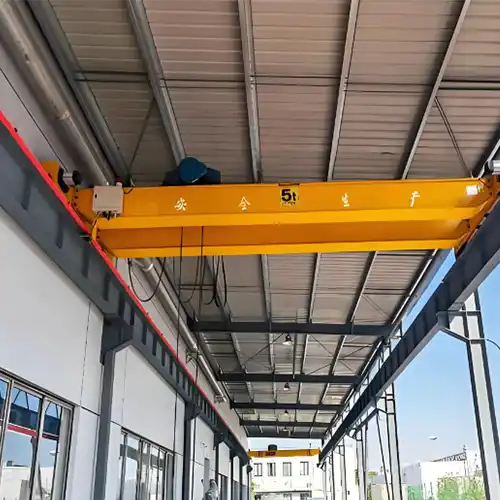
Top running double girder overhead cranes with freestanding crane runway system
Key Components Overview: Each part plays a specific role in making the crane safe, reliable, and efficient for indoor operations.
- Columns: These vertical supports carry the full weight of the crane and its load. Proper foundation and alignment are critical.
- Bridge Girder: The horizontal beam spans the columns and allows the trolley to move along its length.
- Trolley/Hoist: Travels along the bridge to lift and transport materials safely across the workspace.
- Optional Runway Rails: Can be installed to provide extra guidance and stability if needed.
Typical Indoor Use Overview: Freestanding bridge cranes are often chosen for environments that demand repetitive lifting and high capacity.
- Steel workshops moving heavy plates or machinery
- Fabrication plants handling large assemblies
- Injection molding or plastic facilities requiring maximum hook height
A freestanding gantry crane has a horizontal girder supported by legs that rest directly on the floor. Unlike bridge cranes, it can be designed to be mobile or fixed, offering flexibility in facilities that may need temporary or adjustable lifting solutions.
Key Components Overview: These components allow the crane to operate safely while being independent of any building structure.
- Girder: The horizontal beam supports the trolley and hoist for lifting operations.
- Legs (A-frame or H-frame): Transfer the load directly to the floor; their design ensures stability.
- Trolley/Hoist: Moves along the girder to lift and move materials.
- Optional Mobility Wheels or Rails: Allow the crane to travel across the workshop for flexible coverage.
Typical Indoor Use Overview:
Gantry cranes are ideal for facilities where building structures cannot support overhead loads or where flexibility is a priority.
- Temporary or modular workshop layouts
- Maintenance bays or service areas needing movable cranes
- Indoor facilities where floor support is sufficient but roof or ceiling support is unavailable
Key Factors for Indoor Crane Buyers
When choosing a freestanding crane for indoor workshops, several practical factors affect workflow, safety, and long-term usability. Buyers should consider capacity, floor conditions, building constraints, workflow, installation, and future flexibility.
Capacity and Span Requirements
Before selecting a crane, you need a clear understanding of the loads you will be lifting and the area you need to cover. Overestimating can be costly, while underestimating can create safety hazards.
- Determine the maximum load weight your operations require.
- Identify the span or distance the crane needs to cover across the workshop.
- Consider future load increases—choose a crane that can handle slightly more than your current maximum.
Floor and Headroom Limitations
The available floor space and ceiling height directly influence which type of freestanding crane is practical. Poor planning here can restrict hook travel or interfere with other equipment.
- Measure floor space carefully; account for legs, columns, and any moving equipment.
- Check headroom to ensure the hook can reach the highest lifting point safely.
- Consider any obstructions like lighting, ductwork, or overhead piping that may affect installation.
Building Structure Constraints
Even though freestanding cranes don't rely on the building for support, your facility still plays a role in installation and safety. Foundations must handle crane loads, and nearby structures may limit placement.
- Verify floor load capacity for columns or gantry legs.
- Check for levelness and surface quality; uneven floors can affect crane stability.
- Ensure the location allows for safe clearances from walls, doors, and other equipment.
Workflow and Floor Space Considerations
How the crane interacts with your workshop layout impacts efficiency. Poor placement can block traffic or create hazards.
- Plan aisle widths and clearances for forklifts, carts, and personnel.
- Consider how the crane will fit into existing workflow without disrupting operations.
- Decide whether you need fixed coverage or more flexible positioning for multiple bays.
Installation Time and Civil Work Needs
Some cranes require foundations, precise alignment, or other civil works. Understanding this upfront can prevent delays and extra costs.
- Determine if the crane needs columns, foundations, or runway rails.
- Estimate the installation timeline and workforce requirements.
- Factor in potential disruption to ongoing operations during installation.
Future Flexibility or Mobility Needs
Your workshop layout and operational needs may change over time. A crane that is easy to relocate or expand can save money and time in the long run.
- Decide whether you need a fixed crane or a mobile/relocatable solution.
- Consider modular options for future expansion or higher capacity.
- Think about maintenance accessibility and how moving the crane might affect long-term upkeep.
Comparison of Freestanding Bridge vs. Gantry Cranes for Indoor Use
Choosing the right freestanding crane depends on workflow, installation, maintenance, and cost. Here's a practical comparison to help buyers decide.
| Feature / Factor | Freestanding Bridge Crane | Freestanding Gantry Crane |
|---|---|---|
| Structural support | Independent columns supporting the bridge; may need foundation | Legs support entire crane; may be mobile or fixed; no building support needed |
| Floor space usage | Minimal obstruction; columns at sides | Legs occupy floor space; may interfere with forklifts or material flow |
| Headroom / hook height | High hook clearance; good for tall loads | Slightly reduced hook height due to leg frame |
| Span coverage | Wide spans possible; full coverage of workspace | Moderate spans; may be limited by leg spacing or mobility |
| Mobility / flexibility | Fixed; relocations difficult | Can be mobile (wheels/rails); easier to relocate or reconfigure |
| Installation requirements | Requires foundation for columns, precision alignment | Floor-level installation; minimal building modification |
| Maintenance | Simple; fewer moving parts | Legs/wheels may need more maintenance; floor wear possible |
| Cost considerations | Higher upfront (columns + bridge + civil work) | Moderate; less building modification but may need heavier legs for large loads |
Structural Support
How the crane carries its weight and integrates with the workshop layout is a key factor.
- Freestanding Bridge Crane: Supported by independent columns that bear the bridge load. Foundations are required for stability and alignment.
- Freestanding Gantry Crane: Supported by floor-standing legs, either fixed or mobile. Does not rely on the building structure for support.
Floor Space Usage
The way the crane sits in your workshop impacts workflow and space availability.
- Freestanding Bridge Crane: Columns are placed at the sides, keeping most of the floor clear for equipment and personnel.
- Freestanding Gantry Crane: Legs occupy floor space and may interfere with forklifts, carts, or other material handling operations.
Headroom / Hook Height
Maximizing lifting height is critical in many indoor operations.
- Freestanding Bridge Crane: Offers high hook clearance, ideal for tall loads and high stacking operations.
- Freestanding Gantry Crane: Slightly reduced hook height due to the leg frame design; may limit maximum lift.
Span Coverage
The crane's ability to cover the workspace affects efficiency.
- Freestanding Bridge Crane: Can span wide distances and provide full coverage across the workshop.
- Freestanding Gantry Crane: Coverage is moderate and may be limited by leg spacing or mobility restrictions.
Mobility / Flexibility
Consider whether you need the crane fixed or movable.
- Freestanding Bridge Crane: Generally fixed in place; relocation is difficult.
- Freestanding Gantry Crane: Can be mobile on wheels or rails, allowing easier relocation or layout changes.
Installation Requirements
Installation complexity can affect cost and lead time.
- Freestanding Bridge Crane: Requires column foundations, precise alignment, and some civil work.
- Freestanding Gantry Crane: Installed at floor level with minimal building modifications; simpler setup.
Maintenance
Ongoing maintenance affects operational reliability and total cost.
- Freestanding Bridge Crane: Fewer moving parts; maintenance is generally straightforward.
- Freestanding Gantry Crane: Legs, wheels, or rails may require more frequent inspection and maintenance; floor wear can be an issue.
Cost Considerations
Budget is always a practical concern for crane buyers.
- Freestanding Bridge Crane: Higher upfront costs due to columns, bridge, and civil work; often better long-term value for heavy-duty, high-usage operations.
- Freestanding Gantry Crane: Moderate upfront cost; less building modification required, but heavy-duty models may need stronger legs, slightly increasing cost.
Practical Considerations for Indoor Workshops
When choosing a freestanding crane for your indoor workshop, consider workflow, installation, and future needs for safety, efficiency, and cost.
Duty Cycle & Load Type
The type and frequency of loads you lift influence which crane works best.
- Freestanding Bridge Crane: Ideal for heavy and repetitive loads, such as steel plates, machinery parts, or large molds. Its robust design can handle constant use without excessive wear.
- Freestanding Gantry Crane: Better suited for occasional lifting or operations that require flexibility. Perfect for workshops where the crane may not be in constant use.
Floor and Headroom
Floor conditions and available ceiling height determine installation feasibility and lifting efficiency.
- Ensure your foundation or floor can handle the weight of columns (bridge crane) or legs (gantry crane).
- Measure available headroom carefully. Gantry legs may slightly reduce hook height, while bridge cranes can often provide higher lifting clearance.
- Check for any obstructions like lighting fixtures, piping, or ducts that could interfere with crane operation.
Workflow & Obstructions
How the crane interacts with your workshop layout affects productivity and safety.
- Bridge cranes keep the floor mostly clear, allowing forklifts, carts, and personnel to move freely.
- Gantry cranes can block aisles or pathways due to leg placement, so plan adequate spacing and clearances to avoid workflow bottlenecks.
Installation & Lead Time
The complexity of installation can affect your project schedule and upfront cost.
- Bridge cranes: Require precise column foundations and alignment; installation usually takes longer and may involve some civil work.
- Gantry cranes: Typically quicker to install at floor level; modular or mobile options allow faster setup and easier adjustments.
Future Expansion or Relocation
Think ahead—your facility may change, and your crane needs may evolve.
- Bridge crane: Designed for permanent setups; relocation is possible but difficult and costly.
- Gantry crane: Easier to disassemble, move, or reconfigure. Ideal for workshops that may expand, reorganize, or lease different spaces.
Recommendations for Crane Buyers
Choosing the right freestanding crane depends on your workshop layout, lifting requirements, and long-term plans. Here are some practical recommendations based on typical indoor scenarios.
When to Choose a Freestanding Bridge Crane
Freestanding bridge cranes are built for strength, coverage, and consistent use. They’re ideal if your operations involve heavy loads or high lifting frequency.
Consider a bridge crane if:
- You need maximum span coverage and high lifting capacity. This is essential for steel workshops, fabrication plants, or any facility handling large or heavy materials.
- You want minimal floor obstruction, keeping aisles and workspaces clear for forklifts, carts, and personnel.
- Your workshop is permanent and can accommodate foundations for columns, ensuring long-term stability and safe operation.
When to Choose a Freestanding Gantry Crane
Gantry cranes offer flexibility and mobility, making them suitable for workshops where space or layout may change. They work well for temporary setups or facilities that cannot support overhead loads.
Consider a gantry crane if:
- You need flexibility or mobility, such as moving the crane between bays or different parts of the workshop.
- Your floor space can support the crane legs without interfering with workflow.
- The facility cannot carry overhead loads, and adding a bridge crane would require expensive structural modifications.
- You have a temporary or modular setup, where the crane may need to be relocated or reconfigured in the future.
Buyer Tips & Checklist
Buying a freestanding crane for an indoor workshop involves more than choosing a type. Use this checklist to ensure safety, efficiency, and long-term usability.
Confirm Load Capacity, Span, and Hook Height Requirements
Before talking to suppliers, get clear on what your operations demand.
- Verify the maximum load weight you'll lift regularly.
- Measure the span the crane must cover across your workspace.
- Check the required hook height, especially if stacking materials or lifting tall loads.
Evaluate Floor Load Rating for Columns or Legs
Even freestanding cranes put weight on the floor. Make sure your foundation or surface can handle it.
- Determine the floor load capacity for bridge crane columns or gantry crane legs.
- Inspect the floor level and surface condition for stability and safety.
- Identify any areas where reinforcement may be needed.
Verify Duty Class / Service Class for Industrial Usage
Crane performance must match the intensity of your operations.
- Choose the appropriate duty class (light, medium, heavy) for your lifting cycles.
- Ensure the crane is designed for industrial use, not just occasional lifting.
- Consider operation frequency, load type, and environment when selecting service class.
Plan Installation Logistics
Installation can affect cost, downtime, and safety. Plan ahead.
- Decide if foundations or runway rails are required.
- Prepare for alignment and precision work during installation.
- Estimate the lead time and plan around ongoing operations to reduce disruption.
Consider Future Needs
Think beyond current operations to avoid early upgrades or replacements.
- Assess potential facility expansion or reconfiguration.
- Consider mobility options if the crane may need relocation.
- Ensure maintenance access is practical for long-term reliability.
Ask Suppliers for Modular Kits
Modular crane designs can make assembly, adjustment, or relocation easier.
- Look for kits suitable for local fabrication or assembly.
- Confirm the kit allows future upgrades or additional capacity if needed.
- Check for technical support and documentation to simplify installation and operation.
Conclusion
Freestanding cranes provide a reliable solution for indoor workshops and facilities that lack supporting runway structures. They let you safely lift, move, and position heavy loads without relying on the building’s roof or overhead beams.
Choosing the right type—bridge or gantry—comes down to balancing your capacity needs, span coverage, flexibility, and available floor space. Each design has advantages, and understanding these trade-offs ensures the crane fits your workflow, safety requirements, and future plans.
By carefully considering headroom, floor load capacity, installation requirements, and long-term operational needs, crane buyers can make informed decisions that save time, reduce risk, and maximize efficiency. With the right planning, a freestanding crane can become a practical, long-lasting asset in any indoor facility.
Related Products
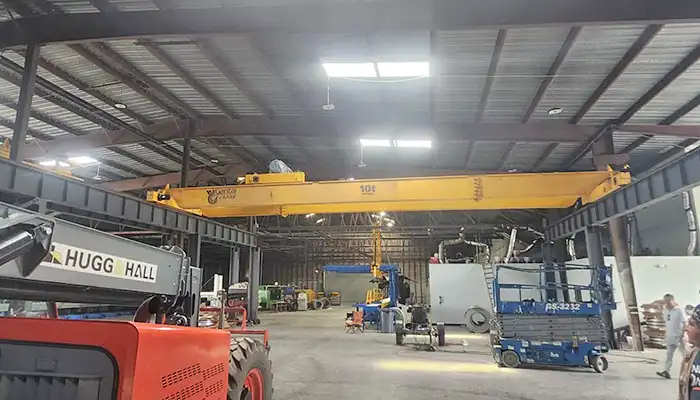
Affordable 10 ton double girder overhead crane with CD/MD hoist trolley, built for U.S. standards, ideal for construction and industrial lifting
Free consultation to Confirm Parameters & Specifications and Get
Latest Crane Price & Crane Rate.
- Types of overhead cranes : _______?
- Optional: Overhead travelling crane, goliath gantry crane,Slewing jib crane, Single girder or double girder crane,small portable crane or kbk crane, etc.
- Capacity of overhead crane: _______?
- Optional: 0.25ton, 0.5 ton, 1 ton, 2 ton, 3ton, 5 ton, 10 ton,15ton, 20ton, 25 ton, 30ton,35ton, up to 550ton, etc.
- Crane span & lifting height : _______?
- Crane travelling length : _____?
- Control of overhead crane:_______?
- Optional: pendant/ remote/cabin control
- Voltage supply of overhead crane:_____?
- Eg,: 380V50/60HZ,3Phase or others,etc.
- Application/usage of crane:_______?
- Eg,: Steel mill, ,injection mold, cement,stone, concrete,granite, general manufacturing, etc.
Just leave a message via the contact form and our hoist and crane engineer will contact you with in 24working hours.
Get In Touch
